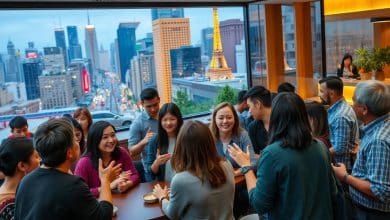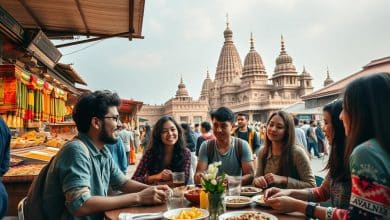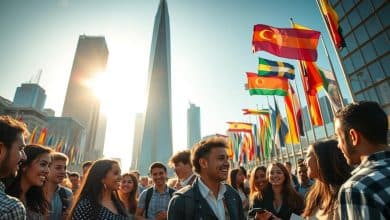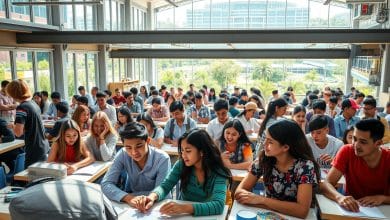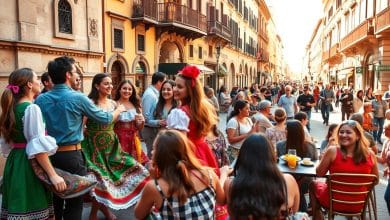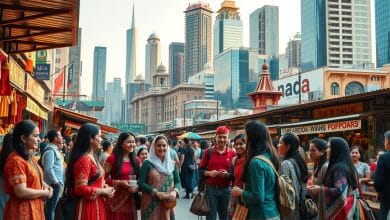Cultural Immersion Benefits for Personal and Professional Growth
In today’s rapidly connected world, understanding diverse perspectives isn’t just nice to have—it’s essential. Engaging deeply with unfamiliar traditions and lifestyles opens doors to growth that classroom learning alone can’t match. This approach, often called cultural immersion, transforms how people interact with the world around them.
Unlike standard education models, this method prioritizes hands-on experiences. Language exchanges, local festivals, or work exchanges let individuals absorb knowledge through real-world practice. These activities push participants to rethink assumptions while building adaptable thinking patterns.
Such experiences sharpen skills like empathy and problem-solving—traits valued in both personal relationships and workplaces. Employers increasingly seek team members who collaborate across borders. Those with firsthand exposure to different customs often stand out in competitive fields.
The world’s interconnected nature demands citizens who navigate complexity with awareness. By stepping outside comfort zones, people gain tools to thrive in diverse settings. This foundation supports lifelong learning and meaningful connections across cultures.
Defining Cultural Immersion
True understanding of varied lifestyles comes from active participation, not observation. This approach moves beyond textbooks, inviting people to live alongside communities and absorb their daily rhythms. It’s about exchanging stories over home-cooked meals or learning crafts from local artisans.
What Is Cultural Immersion?
This practice involves embedding oneself in a community’s way of life. Participants might stay with host families, contribute to household tasks, or join neighborhood gatherings. These interactions create bonds that casual tourism rarely achieves.
Core Components and Practices
Key elements include daily engagement with local practices. Learning regional dialects through conversations builds deeper connections than formal lessons. Sharing in celebrations or helping with family-run businesses offers insights into social structures.
Effective methods often involve:
- Adopting everyday routines of another culture
- Exploring customs through hands-on activities like cooking classes
- Attending spiritual ceremonies to grasp belief systems
Unlike standard tours focused on landmarks, this method prioritizes human connections. It transforms how people perceive different cultures, fostering adaptability and mutual respect.
Exploring “cultural immersion benefits” in Daily Life
Living alongside communities with distinct traditions reshapes how individuals interpret everyday interactions. Simple acts like sharing meals or navigating public transport in unfamiliar settings reveal hidden layers of human connection. These moments spark curiosity while dissolving assumptions.
Enhancing Empathy and Open-Mindedness
Daily exposure to alternative lifestyles teaches people to listen before judging. A parent in Tokyo might discipline children differently than one in São Paulo. Observing these contrasts helps individuals:
- Recognize multiple solutions to common challenges
- Value non-verbal communication styles
- Separate personal biases from universal truths
One study found that participants who engaged deeply with foreign communities showed 34% higher emotional awareness in follow-up assessments.
Building Personal Resilience and Independence
Navigating language barriers or unfamiliar social norms strengthens problem-solving muscles. People learn to adapt routines while maintaining core values. This balance fosters:
- Confidence in handling unexpected situations
- Reduced anxiety about ambiguity
- Sharper decision-making under pressure
As one exchange student noted, “Getting lost in Marrakech’s markets taught me more about resourcefulness than any textbook.” These skills translate directly to workplace adaptability and leadership roles.
Educational and Career Growth through Immersive Experiences
Students today unlock career paths by stepping into foreign classrooms. Educational institutions now design programs that blend academic rigor with real-world exposure, preparing learners for international roles.
Study Abroad and Language Immersion Programs
Full-term study abroad initiatives let learners attend foreign universities while exploring local history. For example, a biology major in Costa Rica might study rainforest ecosystems alongside Spanish language courses. Key differences between program types:
| Aspect | Study Abroad | Language Immersion |
|---|---|---|
| Age Focus | College students | K-12 & adults |
| Duration | Semester/year | Weeks to years |
| Primary Skills | Academic research | Communication skills |
| Career Impact | Global networking | Bilingual proficiency |
Leveraging Experiences for Professional Development
Employers value candidates who demonstrate adaptability across cultures. A marketing graduate with Japanese language skills might secure roles in international business development. These experiences teach:
- Negotiation tactics in multilingual settings
- Cross-cultural team management strategies
- Data interpretation across regional contexts
One HR director noted, “Candidates with verified immersion experiences advance 40% faster in global firms.” Such opportunities create professionals ready to lead diverse teams.
Gaining Unique Insights Through Local Traditions and Celebrations
Local celebrations act as living classrooms where visitors absorb knowledge textbooks can’t capture. From seasonal festivals to family milestones, these events reveal how communities preserve identity through shared practices. They offer rare chances to witness customs that shape daily life across generations.
Participating in Authentic Cultural Festivals
Festivals like Spain’s Three Kings Day or Sydney’s Australia Day beach BBQs demonstrate regional values through food, music, and rituals. Attendees learn by doing—decorating floats for parades or grilling seafood with locals. These hands-on moments expose hidden social dynamics and collective priorities.
| Festival | Location | Key Elements | Insights Gained |
|---|---|---|---|
| Three Kings Day | Spain | Parades, gift-giving | Family-centric traditions |
| Thanksgiving | United States | Shared meals, gratitude | Community bonding practices |
| Australia Day | Sydney | Beach gatherings | Casual social structures |
| Weddings | Global | Rituals, attire | Symbolic customs |
Learning Through Community Engagement
Volunteer programs let travelers assist villages maintaining ancestral ways. Preparing heritage dishes or weaving traditional textiles creates bridges between visitors and hosts. “Joining a Balinese wedding showed me how rituals strengthen community ties,” recalls a recent participant.
Such exchanges help safeguard endangered customs against globalization. Locals gain platforms to teach ancestral skills while visitors carry forward these insights. Shared meals and craft sessions often spark lasting friendships rooted in mutual respect.
Bridging Cultural Gaps: Developing Effective Communication Skills
Language shapes how people connect across borders. Words carry hidden meanings tied to history and values. For instance, Japan’s omotenashi—meaning selfless hospitality—reflects centuries of service traditions. Grasping these nuances requires more than memorizing phrases.
Overcoming Language Barriers in Real-World Settings
Classrooms teach grammar rules, but streets teach context. Ordering food in Mexico City markets or asking directions in Seoul subway stations forces quick thinking. Mistakes become lessons. A study found immersive learners master conversational fluency 3x faster than classroom-only peers.
| Learning Method | Vocabulary Retention | Contextual Understanding |
|---|---|---|
| Classroom | 45% after 6 months | Limited |
| Immersion | 78% after 6 months | High |
Daily interactions reveal slang and humor textbooks miss. A traveler in Italy learns “in bocca al lupo” (good luck) isn’t about wolves but theater traditions. These discoveries build confidence to navigate complex social norms.
Fostering Intercultural Dialogue and Understanding
Nonverbal cues often speak louder than words. In Finland, silence signals respect during negotiations. In Brazil, animated gestures show engagement. Key skills developed through practice:
- Reading facial expressions in tense discussions
- Adjusting speech pace for clarity
- Recognizing status hierarchies in group settings
One software engineer shared: “Leading teams across four time zones taught me to pause more and assume less.” Such adaptability strengthens workplace relationships and client trust globally.
Preserving and Sharing Cultural Heritage Through Immersion
Hands-on engagement with time-honored practices offers more than just souvenirs—it safeguards legacies. By participating in ancestral crafts or preparing heritage recipes, travelers become active contributors to preserving global traditions. These activities create living bridges between generations and geographies.
Experiencing Traditional Arts, Crafts, and Cuisine
Imagine shaping clay using techniques unchanged for centuries or grinding spices for family recipes guarded across lifetimes. In India’s Himalayan villages, visitors knead dough for roti alongside local chefs, discovering how food carries stories of migration and survival. Such exchanges turn observers into custodians of vanishing knowledge.
Weaving workshops in Guatemala reveal intricate patterns representing community histories. Each thread placement teaches mathematical precision intertwined with symbolic meaning. These lessons in craftsmanship foster respect for the patience required to master art forms facing extinction.
Travelers often return home with abilities that enrich their daily lives—like fermenting kimchi after Korean farm stays or crafting Maori carvings in New Zealand. One participant noted: “Learning to make Balinese offerings connected me to rituals that sustain entire villages.” Shared knowledge becomes part of personal growth while supporting artisans economically.
Families hosting visitors gain pride in showcasing their heritage, ensuring traditions thrive beyond tourism. This mutual exchange strengthens global networks of cultural appreciation, proving that every hands-on lesson helps write humanity’s collective story.
Conclusion
Stepping into unfamiliar ways of life reshapes how people engage with the world. Those who embrace immersive experiences often return home with fresh perspectives that challenge their previous assumptions. This shift can create reverse culture shock—a sign of meaningful transformation where old routines feel strangely limiting.
These journeys build skills that classrooms can’t replicate. Navigating foreign social norms sharpens problem-solving abilities, while daily interactions in new environments teach adaptable communication styles. Employers increasingly seek these qualities in global teams, where understanding diverse cultures drives innovation.
As borders blur in our interconnected age, such opportunities prepare individuals to lead with empathy. The personal growth gained through deep engagement with different communities becomes lifelong currency—one that enriches both professional paths and human connections across continents.
FAQ
How does engaging with diverse traditions improve daily life?
Can language barriers hinder meaningful interactions abroad?
What career advantages come from studying abroad?
Why participate in community-driven festivals or events?
How do traditional crafts or cuisine preserve heritage?
Does living abroad build personal resilience?
Published on: 18 de August de 2025


